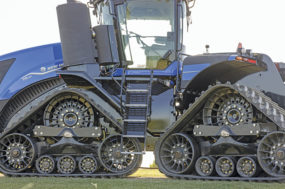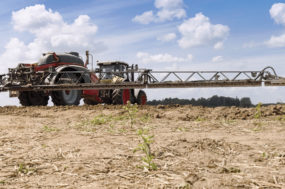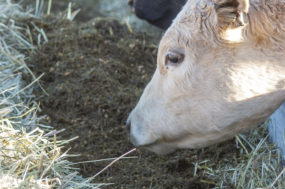Mycotoxin contamination can affect even the most well-run dairy farms. It’s important for farmers to detect mycotoxins early so they can mitigate the risk to their animals and minimize any future health and production issues that could arise in the future.
2019 harvest analysis of mycotoxins
In 2019, the U.S. experienced excessive moisture during the growing season. These extreme weather conditions and moisture levels can reduce yields and induce plant stress, and they can also lead to future issues for the crop, including molds and mycotoxins. Increased moisture can allow fusarium molds to flourish, producing a variety of mycotoxins that include deoxynivalenol (DON), fusaric acid, T-2, HT-2 and zearalenone (ZEN). These mycotoxins can cause a variety of health and performance issues in livestock, such as reduced feed intake, decreased milk production, poor reproduction, depressed gut and internal organ health, and an increase in secondary health issues.
Mycotoxins are a concern for dairy producers, as they influence feed quality and animal health. Mycotoxins are produced by certain species of molds and can have toxic properties that impact animal health and performance. I work primarily with dairies in Wisconsin and Minnesota, and upon analyzing more than 100 samples of corn silage from 2019 submitted to the Alltech 37+ mycotoxin analytical services laboratory, the results showed an increased level of mycotoxins.
These samples had an average of 7.14 mycotoxins, with a range of three to 14 mycotoxins per sample. The number of mycotoxins present is crucial, as feeds that contain multiple mycotoxins pose a greater risk to livestock performance and health than feeds that contain only one or two. This can be the result of additive and/or synergistic effects between the mycotoxins.
The levels of mycotoxins found in the 2019 crop are significantly higher than average values. Corn from 2019 can be fed to livestock, but producers should test their own corn silage and develop a program that will harbor the least amount of risk to livestock health and performance.
Type B trichothecenes (DON) (at 100%) and fusaric acid (at 99%) were the two most commonly occurring mycotoxin groups in all of the samples, while emerging mycotoxins and zearalenone were present in 96% and 60% of the samples, respectively. Trichothecenes and fusaric acid are typically two of the most commonly occurring mycotoxin groups in corn and corn products. Zearalenone has increased in both occurrence and in the level analyzed over the past two years, which were also the two wettest consecutive years in more than 12 decades.
For ruminants, the risk is higher in calves due to their undeveloped immune systems and rumens, making them high-risk for feed intake; dairy cows are more moderately at risk regarding their rumen function and gut health.
Understanding the risks of mycotoxins
It starts in the field, with tillage practices. Turning soil so soil microbes can break down residue and trash, along with crop rotation, are, in my opinion, the two biggest factors for plant health and stress. Rotating crops – and not growing corn year after year – can often help to break the cycle of some of the molds and mycotoxins that may be in the field, but there is no guarantee.
Some producers use their fall corn silage as soon as December, while others hold off until early the following year. When we look at the mycotoxins brought in on fresh samples, that level of mycotoxin will not decrease, so we’re going to have that base level no matter what. What we want to do is create an environment that doesn’t increase the level of mycotoxins through storage and fermentation.
The colder weather that comes with winter will typically hold the mycotoxin level at bay, for the most part, but once the weather turns warmer, thanks to moisture in the air and the thaw taking place, there can be an increase of mycotoxins, including penicillium mycotoxins, which are storage mold mycotoxins. Penicillium mycotoxins can lead to many issues in cattle, including digestive disorders, inconsistent manure, ketosis in fresh animals and a suppressed immune system. Penicillium also leads to dry matter loss, as it infects silage to the point where it shouldn’t be fed to any animals.
The threat of mycotoxins is real, but it is important to understand your own personal level of risk, as each farm will face different risks. We need to understand where the mycotoxins are coming from and which mycotoxins we are dealing with, so we first test a sample and then work with producers and their nutritionists to create a plan to reduce and/or mitigate the risk to their animals. I have had great success in working with producers and their nutritionists to evaluate and understand what their specific dairy is dealing with regarding their mycotoxin threat level and, as a result, determining how we can work together to reduce that risk or mitigate the impact of the mycotoxins present.
Mycotoxins are everywhere and at different risk levels. Each region has different temperatures, climates, storms and weather patterns, so every region is unique in the type of mycotoxins they may come up against. I have also noticed that the types and levels of mycotoxins can be different from farm to farm within the same region; neighboring dairies can have different risk levels and mycotoxins present.
Testing for mycotoxins
Our on-farm dairy support team goes out to dairies and works with producers, along with their nutritionists, to evaluate forages. We look at their storage units, whether it’s a pile, a bunker or a bag unit. First, we look for visual identification and whether or not we can see any bad or infected areas, such as spoilages or molds producing mycotoxins. In some cases, you can see those mycotoxin infections with your naked eye, but not always, so we also use a thermal-imaging camera.
The thermal-imaging camera helps us identify any heating or activity that may allow mold and mycotoxins to grow more rapidly. Then we can send a sample to the lab in Nicholasville, Kentucky, to thoroughly test for all of the mycotoxins that might be present.
I see a lot of cows and talk to a lot of producers and herdsmen, and you can definitely see the impacts of feeding mycotoxins to cows, including changes in dry matter intake and fluctuation in milk production components like butterfat or protein. While we are walking the pens, we look for signs that could include inconsistency or variability in the manure and/or spit-up cuds, since cows spitting up their cuds is a classic sign of high levels of DON. It’s important to study the cows closely to read and understand any changes in their behavior. Other signs we look for while in the pens are rumen fill on the cows, their hair coat quality and whether they appear to be lethargic or if their eyes are sunken in.
Alltech conducts an annual corn silage harvest analysis every fall and has seen an increase in the average number of mycotoxins per sample each year. The good news is that more producers are beginning to understand mycotoxins, the impact they can have, where they come from and how we can work together to mitigate the risks associated with mycotoxins.










